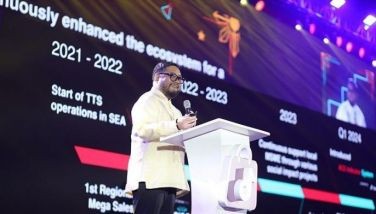New initiative brings hope to RP coral reefs
December 9, 2001 | 12:00am
 A new initiative in marine conservation is breathing new life into the dying coral reef ecosystem of the country. And it — the pilot project — is happening in Caw-oy Coral Farm on Olango Island, Lapulapu City.
A new initiative in marine conservation is breathing new life into the dying coral reef ecosystem of the country. And it — the pilot project — is happening in Caw-oy Coral Farm on Olango Island, Lapulapu City.
Members of the Caw-oy Fisherfolk Organization built 275 coral nursery units (CNUs) on which they transplanted 22,000 coral fragments. It is a two-hectare site which employs 25 families who, aside from working on the farm, provide round-the-clock protection.
The program was initiated by marine biologists Dr. Thomas Heeger of Germany and Dr. Filipina Sotto of the Philippines and by the Commission on Higher Education—Center of Development Fund. Also participating in the project is the International Marinelife Alliance with its new initiative in marine conservation and protection, the Coral Reef Rehabilitation Program. The German Embassy in the Philippines is funding the coral farm.
In the first phase of the program, artificial substrata are produced and coral species which can respond positively to artificial propagation are chosen. Of the 680 coral species which grow wild in the country, at least 130 species are cultivated in the coral farm.
Coral fragments for growing-out in the nurseries are meticulously cut off from "donor" or "mother" coral with the use of a pair of pliers for the branching type, or hammer and chisel for the encrusting massive type. Harvesting is done near the farm area. This way the marine scientists who collect the fragments can precisely monitor and document the impact of harvests upon the wild stocks. The practice is to take 10 to 20 percent only of the donor colony which can effectively regenerate in six to eight weeks.
The fragments are tied to the fossil limestone (or a clean limestone base such as the rough side of a kitchen tile) with ordinary galvanized iron wire. In the nursery coral units, the fragments regenerate and attach themselves to the substrate in about three to four weeks.
Depending on the species, it takes one to three months to grow-out six to eight centimeters of stony coral fragments, the size suitable enough for translocation to a damaged reef colony. Growing out in CNUs minimizes predation from fishes and invertebrate. The CNUs are cleaned of sediment and algae. Here, the survival rate is recorded at 87 percent after four months.
The technology used in the coral farm rehabilitates one hectare of reef colony at $2,100 at two fragments per square meter. Two damaged reef sites — one in Marigondon, Lapulapu City (4,000 coral fragments) and another in Camotes Island, Cebu City (2,000 coral fragments) — are alive again with the application of the transplant method.
The Caw-oy Coral Farm is a showcase of how a community-based program can successfully transform destructive fishing practices into coral farming as their source of livelihood.
Initiatives for marine conservation — among them coral farming, back to the hook-and-line fishing for live food fish and barrier net for aquarium pet fish instead of cyanide fishing, training of fisherfolk and countrywide information and educational campaign on the human-and-naturally-induced stresses on the sustainable capability of the seas’ resources — are today’s answer to receding coral reefs and fish depletion.
The seas and the coral reefs in them need help from overfishing due to rapid population growth placed at 2.4 percent, marine pollution, unregulated coastal development, malpractices in fishing (dynamite, cyanide, muro-ami, paaling, poaching, among several others).
As a result, only 10 percent of the country’s 27,000 square kilometers of coral reefs, considered the rainforest of the ocean, are at present in excellent condition. Moreover, the fish catch dropped from 20 to two kilograms in less than three decades (1969-1998).
Fortunately, stakeholders of marine resources are doing conservation work on top of advocacy initiatives of the friends of the sea to win over bad elements to their side. One is tempted to ask, however: "Is there still time to recover the oceans’ mega-biodiversity to serve the growing needs of the next generations?"
BrandSpace Articles
<
>
- Latest
Latest
Latest
March 4, 2024 - 3:32pm
By Ian Laqui | March 4, 2024 - 3:32pm
March 4, 2024 - 2:12pm
By Kristine Daguno-Bersamina | March 4, 2024 - 2:12pm
February 17, 2024 - 2:31pm
February 17, 2024 - 2:31pm
February 13, 2024 - 7:24pm
By Gaea Katreena Cabico | February 13, 2024 - 7:24pm
February 13, 2024 - 7:17pm
By Ian Laqui | February 13, 2024 - 7:17pm
January 30, 2024 - 4:25pm
By Ian Laqui | January 30, 2024 - 4:25pm
Recommended
























